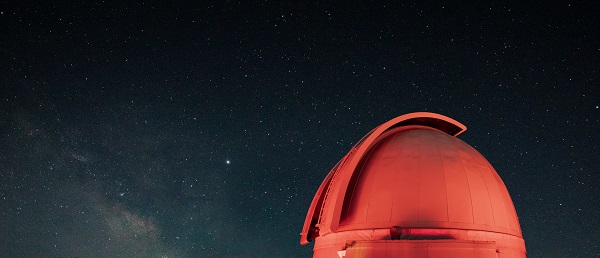Editor’s Note: It is a new year and we continue looking up as HMNS Astronomer James Wooten explains the sky happenings for the month of January, including the science behind perihelion.
Jupiter is still in the evening sky; look for it in the south southwest at nightfall. Jupiter is brighter than any star we ever see at night.
Saturn remains in the southwest at nightfall for one more month. Notice how it appears a little lower to the southwestern horizon each evening until by the end of the month, it sets in twilight.
Venus emerges into the evening sky this month. It is slightly higher in the southwest at dusk each evening. On Sunday, January 22, Venus is only about 1/3 of a degree to the left of Saturn. You’ll need a clear view all the way to the horizon to view the Venus/Saturn pair that night; the planets are only ten degrees (as tall as your outstretched fist) by the time the sky darkens.
Mars was up all night long last month, and is now well placed for observing in the evening. As Earth now pulls away from Mars after passing it last month, Mars is a little dimmer each evening. In January 2023, though, Mars still outshines most of the stars at night.

Watch for the Great Square of Pegasus in the west at dusk. Taurus, the Bull is high in the south. Look for the Pleiades star cluster above reddish Aldebaran. Dazzling Orion, the Hunter takes center stage on winter evenings. Surrounding Orion are the brilliant stars of winter. Orion’s belt points down to Sirius, the Dog Star, which outshines all other stars we ever see at night. The Little Dog Star, Procyon, rises with Sirius and is level with Orion’s shoulder as they swing towards the south. To the upper left of Orion’s shoulder is Gemini, the Twins.

The Great Square of Pegasus sets in the western sky. Jupiter is high in the west. Taurus, the Bull, is almost overhead, containing Mars. Dazzling Orion, the Hunter is high in the southeast, with his two dogs behind him. Sirius, the Big Dog Star, is the brightest star we ever see at night. Leo, the Lion, rises in the east. In the north, the Big Dipper gradually re-enters the evening sky.
Moon Phases in January 2023
Full Jan. 6, 5:08 p.m.
Last Quarter Jan. 14, 8:10 p.m.
New Jan..21, 2:53 p.m.
1st Quarter Jan..28, 9:19 a.m.
The New Moon of January 21 is the second New Moon after the winter solstice. Accordingly, it marks the Chinese New Year; the Year of the Rabbit begins as the Year of the Tiger ends. (If you adjust the time to China’s time zone, you’ll see that the date there is January 22).

At 1:59 pm on Wednesday, January 4, the Earth is as close to the Sun as it will ever get this year; it reaches perihelion. So why is it cooler now than in summer? That’s because Earth’s orbit is almost, but not quite, a perfect circle. The Earth-Sun distance varies only by about three percent, which is just not enough of a difference to make us warmer when we come closer to the Sun. The Earth’s tilt on its axis, not its changing distance from the Sun, causes the seasons.
The latest sunrise of the year (7:17 am) occurs on January 10. That’s due to the same effect I mentioned last month; Earth’s slight acceleration near perihelion makes sunrise, noon, and sunset all occur a little later each day. Most of us sleep through sunrise but are awake for sunset, so you’ve probably noticed that sunsets are significantly later than last month. However, the days aren’t really that much longer, as sunrises have been getting later as well. Although the midday Sun is a little higher in the sky now than on the solstice, the difference is still small. After mid-month, when the Sun starts taking a much more noticeably higher, longer path across the sky each day, we’ll start seeing earlier sunrises and later sunsets as days lengthen.
Our George Observatory is now open every Saturday night for observing! Purchase tickets in advance on our website.
Clear Skies!
Miss last month’s sky happenings? See them here.






